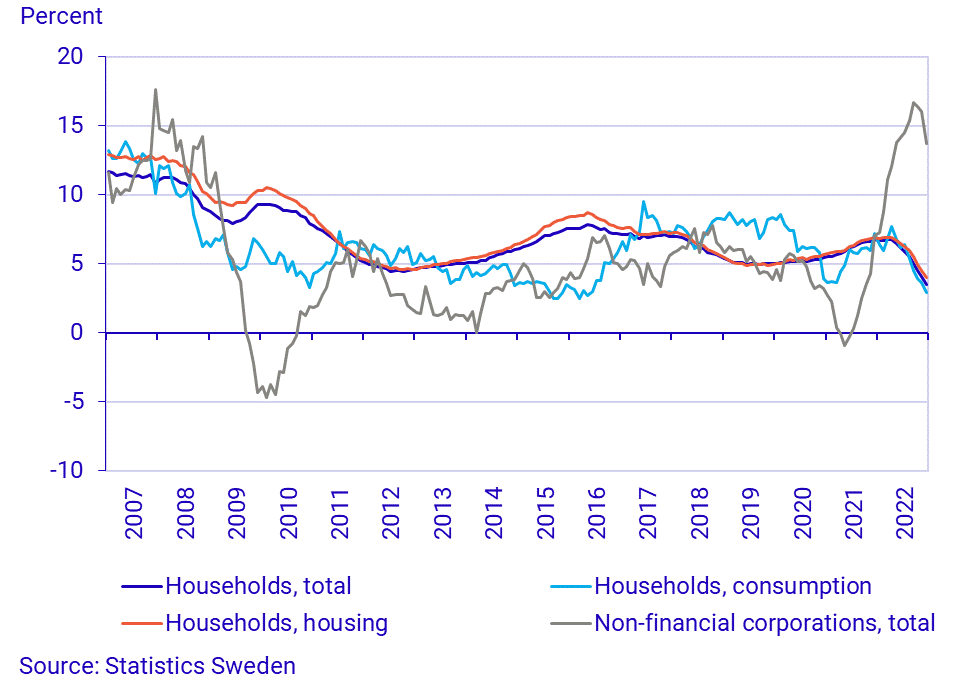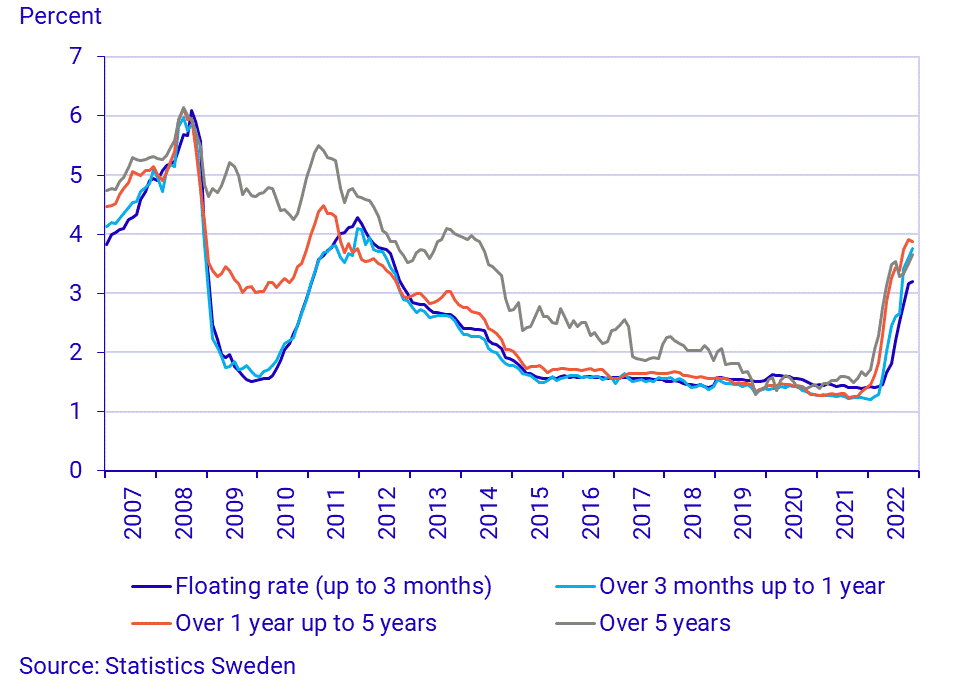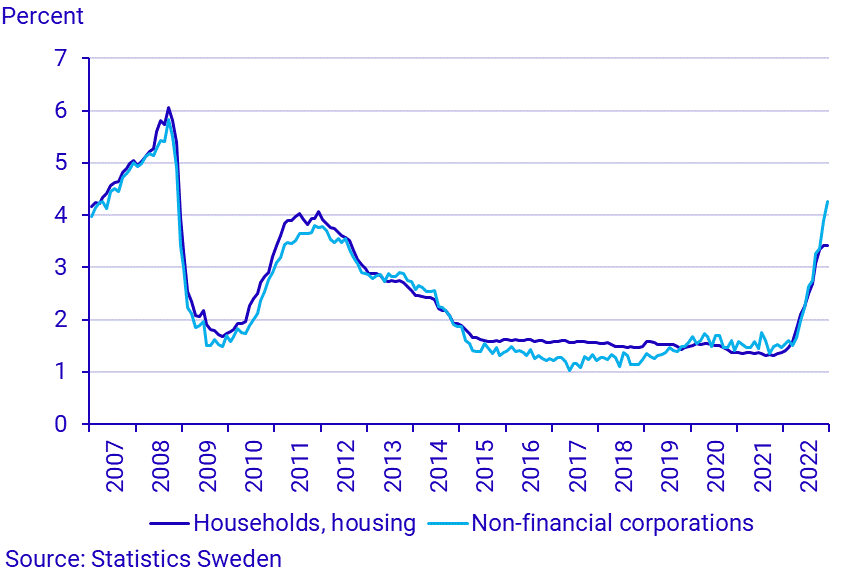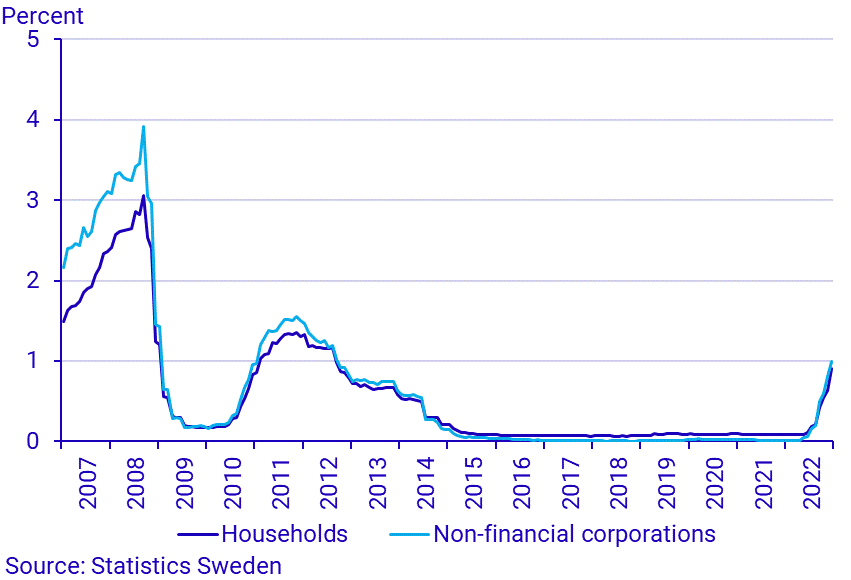Financial market statistics, December 2022
Raising interest rates and decreasing growth rate for lending to non-financial corporations
Statistical news from Statistics Sweden 2023-01-27 8.00
The annual growth rate of mortgages to households from monetary financial institutions was in December 2022 4.0 percent. The growth rate for lending to non-financial corporations was 13.7 percent. The average floating interest rate on mortgages continued to increase, while a decrease is seen in fixed mortgage rates.
Developments in December 2022 summarised
Lending
- The annual growth rate of lending to households was 3.5 percent, which is the lowest level since the starting month of this time series (January 2006). Mortgages accounted for 83 percent of total lending to households. The annual growth rate for consumption loans was 2.9 percent and accounted for 6 percent of total lending to households.
- The annual growth rate for lending to non-financial corporations was in December 13.7 percent, a decrease from 16.0 percent in November 2022.
- In total, lending from MFIs to households and non-financial corporations amounted to SEK 7 853 billion. Loans to households accounted for 62 percent (SEK 4 903 billion) and loans to non-financial corporations accounted for 38 percent (SEK 2 950 billion).

- The annual growth rate of mortgages from institutes other than MFIs on mortgage markets, known as mortgage credit companies, was noted to 27.5 percent. Mortgage credit companies accounted for 1.3 percent (SEK 52 billion) of total mortgages to households.
Deposits
- In total, deposits from MFIs to households amounted to SEK 2 660 billion. On demand deposits accounted for 85 percent (SEK 2 253 billion).
- Notes and coins held by Swedish non-bank public, previously defined as the money supply measurement M0, amounted to SEK 64 billion in November 2022. The money supply M3 amounted to SEK 4 898 billion and had an annual growth rate at 2.5 percent.
Interest rates on lending and deposits
- The average interest rate on new agreements for mortgages to households was 3.41 percent. The average floating rate on mortgages was 3.33 percent. Corresponding interest rate in December 2021 was 1.40 percent.
- The average fixed interest rate between 1 and 5 years on new agreements for mortgages to households was 3.79 percent, against 3.88 percent in November 2022.

- The average interest rate on new agreements for lending to non-financial corporations was 4.26 percent. The floating interest rate for new agreements to non-financial corporations was 4.30 percent.
“In December 2022 we observe some distinctive values for the non-financial corporations. The average interest rates have not been so high since November 2008. The decreasing annual growth rate for lending, from 16.0 percent in November 2022 to 13.7 percent in December 2022, is also a change which have not been observed since 2008”, says Anna Sundell Kastberg, economist at Statistics Sweden.

- Households’ average interest rate on new bank deposits was 0.90 percent. The interest rate on accounts with fixed periods or a limited number of free withdrawals was 1.54 percent. The corresponding interest rate in December 2021 was 0.21 percent.
- Non-financial corporations’ average interest rate for new bank deposits was 0.99 percent. The interest rate on accounts with fixed periods or a limited number of free withdrawals was 2.12 percent.

About the statistics
The financial market statistics cover mainly monetary financial institutions (MFIs), but also include new institutes on mortgage markets, known as mortgage credit companies. Unless otherwise stated, the statistical news refers to MFIs.
The statistics include balance sheet statistics (including lending and deposits), interest rates, and monetary aggregates. International banking statistics are also published on a quarterly basis.
Definitions and explanations
The financial market statistics are compiled monthly. Revisions of the statistics may occur.
Monetary financial institutions (MFIs) comprise banks, housing credit institutions, finance companies, institutions financing municipalities and companies, monetary securities companies and monetary investment funds (money market funds).
Mortgage credit companies refers to non-MFIinstitutions that have authorisation from Finansinspektionen to issue mortgages. Usually, mortgage credit companies sell the mortgages to alternative investment funds (AIFs). The AIFs included in the financial markets statistics are linked to mortgage credit companies, and whose assets mainly comprise mortgages.
Growth rates are calculated to illustrate the development of transactions as from the corresponding period the previous year. The rates are calculated based on changes in stocks; adjustments are made so that the growth rate is not affected by stock changes unrelated to transactions, for example if an institute is added or removed from the population.
Lending to households is divided into three categories: housing loans, consumer credit, and other lending. The purpose of a loan is not directly measured, but is approximated by categorising lending by type of collateral. Housing loans are defined as loans to private individuals or entrepreneurial households with housing as collateral. Consumer credit refers to lending to private individuals, generally without collateral. Other lending includes all other lending, for example lending to non-profit institutions serving households.
New agreements refer to agreements concluded during a given month. Interest rate statistics on new agreements is a way of measuring the price formation on loans and deposits in a given period. These statistics include all financial agreements in which the terms and conditions affecting the interest rates on deposits and lending are determined for the first time. The statistics also include renegotiations of existing loans and relocation of loans. Changes in floating interest rates due to automatic adjustments are not considered new agreements.
Next publishing will be
The next item of statistical news in this series is scheduled for publication on 2023-02-27.
Statistical Database
More information is available in the Statistical Database
Feel free to use the facts from this statistical news but remember to state Source: Statistics Sweden.
